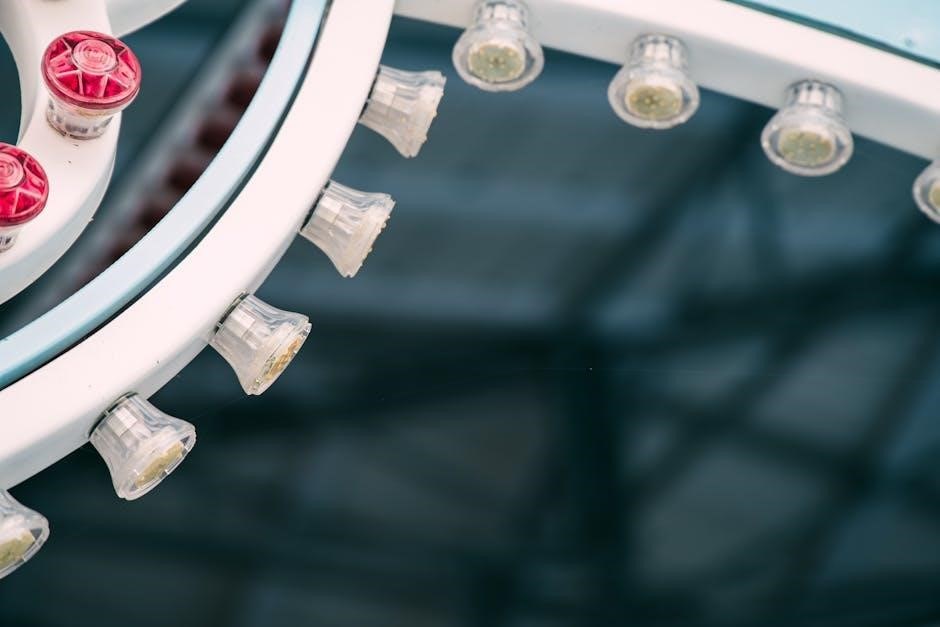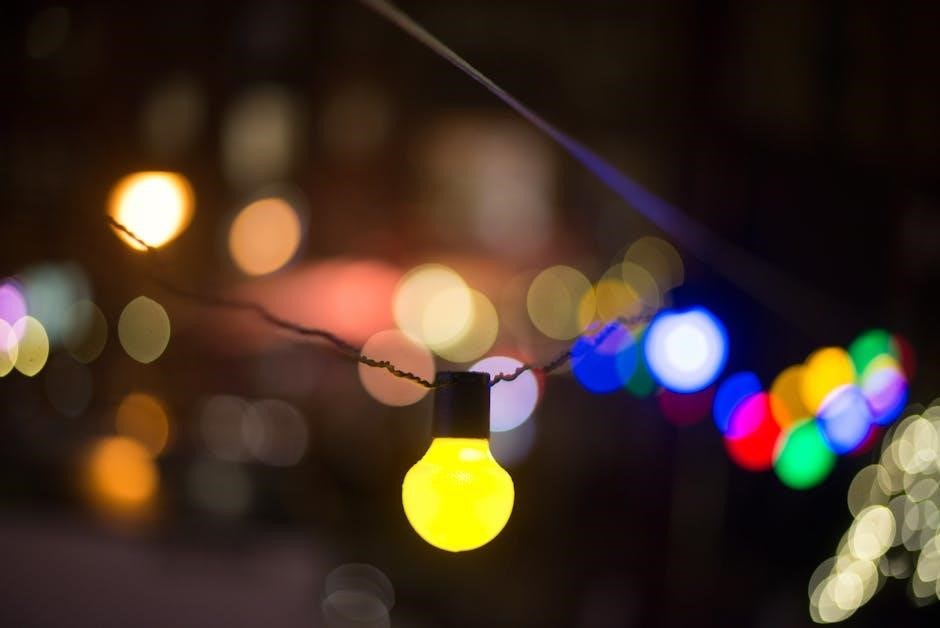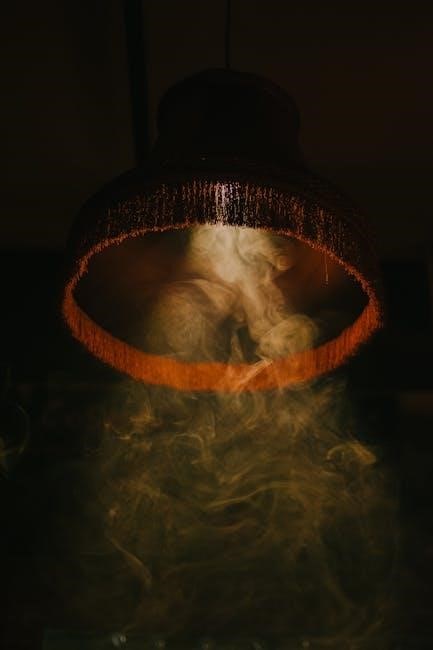Color temperature refers to the color appearance of light, measured in Kelvin (K). It influences ambiance, task efficiency, and visual comfort, making it crucial for lighting decisions;
1.1 What is Color Temperature?
Color temperature, measured in Kelvin (K), describes the color appearance of light, ranging from warm to cool tones. Lower Kelvin values (e.g., 2700K-3000K) produce warm, yellowish light, while higher values (e.g., 5000K-6500K) emit cool, bluish tones. This measurement impacts ambiance, task efficiency, and visual comfort, making it essential for selecting lighting that suits specific needs and environments.
1.2 Importance of Understanding Color Temperature in Lighting
Understanding color temperature is crucial for selecting lighting that enhances ambiance, productivity, and comfort. It helps create harmony between spaces and activities, ensuring optimal visibility and mood. Proper color temperature reduces eye strain, improves focus, and supports circadian rhythms. By balancing aesthetics and functionality, it empowers users to tailor lighting to specific needs, whether residential, commercial, or outdoor, ensuring efficient and pleasing environments.
Color Temperature Ranges and Their Effects
Color temperature ranges from warm to cool, influencing ambiance and functionality. They affect mood, task efficiency, and visual comfort, shaping the atmosphere of any space effectively.
2.1 Warm White (2700K-3000K)
Warm white light, ranging from 2700K to 3000K, emits a cozy, yellowish glow. It creates a relaxing ambiance, ideal for residential spaces like living rooms and dining areas. This soft, warm tone promotes comfort and is often used in traditional lighting setups. However, it may not be the best choice for tasks requiring high color accuracy, as it can tint objects with a reddish-yellow hue. Its calming effect makes it perfect for environments where relaxation is prioritized over brightness or precision.
2.2 Soft White (3000K-3500K)
Soft white light, spanning 3000K to 3500K, offers a balanced, neutral glow. It blends warmth and brightness, creating a calming yet functional atmosphere. Ideal for bedrooms, kitchens, and general lighting, soft white enhances relaxation while providing sufficient light for tasks. Its moderate tone is easier on the eyes compared to cooler options, making it suitable for spaces requiring both ambiance and practicality.
2.3 Daylight (3500K-5000K)
Daylight bulbs, ranging from 3500K to 5000K, emit a bright, neutral-to-cool light that mimics natural daylight. This range is ideal for tasks requiring clarity and color accuracy, such as reading, cooking, or task lighting. Daylight bulbs enhance focus and energy, making them popular in commercial and industrial settings. They are also used in retail to highlight products and in medical environments for precise illumination. Their crisp, vibrant light promotes alertness and is versatile for various applications.
2.4 Cool Daylight (5000K and Above)
Cool daylight bulbs, with temperatures above 5000K, produce a crisp, intense light resembling natural daylight. These bulbs are ideal for environments requiring maximum alertness and clarity, such as healthcare facilities, outdoor spaces, and task-focused areas. They enhance visibility and color accuracy, making them suitable for detailed work. However, they can feel harsh in residential settings, so they are often used in commercial or industrial contexts where brightness and focus are prioritized. Their cool tone promotes productivity and is energy-efficient for specific applications.
How Color Temperature Impacts Mood and Ambiance
Color temperature significantly influences mood and ambiance, with warm tones promoting relaxation and cool tones enhancing alertness, creating distinct emotional and environmental atmospheres in spaces.
3.1 Warm Tones for Relaxation
Warm color temperatures, typically between 2700K-3000K, create a cozy and calming atmosphere, ideal for relaxation. These soft, yellowish hues mimic natural light at sunrise or sunset, promoting a sense of comfort and reducing eye strain. Warm tones are often used in residential settings, such as living rooms or bedrooms, to foster a soothing environment that encourages unwinding and lowers stress levels, enhancing overall well-being and creating a welcoming ambiance.
3.2 Cool Tones for Energy and Focus
Cool color temperatures, typically above 3500K, emit a bright, bluish-white light that enhances alertness and focus. These tones mimic natural daylight, making them ideal for task-oriented spaces like home offices or kitchens. Cool tones can boost energy levels and mental clarity, creating an environment that fosters productivity and concentration. They are particularly effective in commercial settings, where brightness and alertness are essential, and are often recommended for areas requiring precision and focus.

Applications of Different Color Temperatures
Different color temperatures are applied in residential, commercial, and outdoor settings to create specific atmospheres, enhance tasks, or improve visibility, ensuring optimal lighting for various purposes.
4.1 Residential Lighting
Residential lighting uses color temperature to create specific moods and functionalities. Warm white (2700K-3000K) is ideal for cozy, relaxing spaces like bedrooms and living rooms, while soft white (3000K-3500K) offers a balance of warmth and brightness, perfect for kitchens and dining areas. Daylight (3500K-5000K) enhances task-oriented spaces like home offices or reading areas, providing clarity and focus. The right color temperature can significantly enhance comfort and productivity in home environments, tailored to individual preferences and needs.
4.2 Commercial Lighting
Color temperature plays a critical role in commercial lighting to enhance productivity and ambiance. Offices often use daylight (3500K-5000K) to promote focus, while cool daylight (5000K+) is ideal for tasks requiring precision. Retail spaces may opt for soft white (3000K-3500K) to create a welcoming atmosphere. Tunable lighting systems enable businesses to adjust color temperature throughout the day, boosting efficiency and customer experience. The right color temperature can significantly influence branding and overall business success, making it a key consideration in commercial settings.
4.3 Outdoor Lighting
Outdoor lighting benefits from specific color temperatures to ensure functionality and aesthetics. Cool daylight (5000K+) is often used for security and visibility, while soft white (3000K-3500K) creates a warm, inviting ambiance for landscapes. Warm white (2700K-3000K) is ideal for decorative lighting, enhancing curb appeal. Proper color temperature selection can reduce glare and improve safety, making it essential for both residential and public outdoor spaces to balance practicality and visual appeal effectively.
Color Rendering Index (CRI) and Its Role
The Color Rendering Index (CRI) measures how accurately a light source displays colors compared to natural light. Higher CRI values (90-100) enhance color accuracy, crucial for tasks requiring precise color perception.
5.1 What is CRI?
The Color Rendering Index (CRI) is a measure of how accurately a light source displays colors compared to natural daylight. Rated on a scale from 0 to 100, higher CRI values indicate better color reproduction. For example, a CRI of 100 represents perfect color accuracy. Lighting with high CRI is essential for tasks requiring precise color perception, such as art, design, and retail, where true-to-life colors are critical. Lower CRI can make colors appear washed out or unnatural.
5.2 How CRI Relates to Color Temperature
While color temperature determines the warmth or coolness of light, CRI measures how well it renders colors. A high CRI ensures colors appear natural under a specific color temperature. For instance, a 5000K bulb with a high CRI (e.g., 90+) will display colors more accurately than one with a lower CRI. Both factors work together to enhance visual comfort and task performance, though they are distinct measurements. A light source can have a specific color temperature but vary in CRI, impacting color perception.
Dimmability and Smart Lighting Options
Dimmable bulbs and smart lighting systems allow adjustable brightness and color temperature, enhancing energy efficiency and user convenience, while IoT integration enables seamless control over lighting settings remotely.
6.1 Dimmable Bulbs and Color Temperature
Dimmable bulbs offer flexibility in adjusting brightness and warmth, allowing users to customize lighting based on color temperature preferences. Higher color rendering index (CRI) ensures accurate color reproduction, enhancing visual clarity. Smooth dimming capabilities enable seamless transitions between warm and cool tones, creating versatile ambiance for various settings. This feature is particularly beneficial for tasks requiring precise lighting, such as art studios or reading areas, where adjustable illumination is essential for comfort and productivity.
6.2 Smart Lighting Systems for Adjustable Color Temperature
Smart lighting systems integrate advanced technology, enabling seamless control over color temperature through IoT devices. Users can adjust settings via apps, creating dynamic environments suited to specific tasks or moods. These systems often include features like scheduling, voice control, and energy monitoring. With tunable LED bulbs, smart lighting offers precise color temperature adjustments, enhancing flexibility and convenience for modern homes and workplaces, ensuring optimal lighting conditions throughout the day.

Energy Efficiency and Color Temperature
LED bulbs offer high energy efficiency across color temperatures. Lower Kelvin ratings generally consume less energy, while higher temperatures may increase consumption slightly due to brighter output.
7.1 LED Bulbs and Their Energy Efficiency
LED bulbs are highly energy-efficient, consuming significantly less power than traditional incandescent bulbs. They maintain efficiency across color temperatures, with lower Kelvin ratings generally using less energy. While warmer tones (2700K-3000K) are more energy-efficient, cooler tones (5000K+) may consume slightly more due to higher brightness. Despite this, LEDs remain a superior choice for energy savings, with lifespans of up to 50,000 hours. Dimmable LEDs further enhance energy efficiency by allowing adjustable brightness.
7.2 How Color Temperature Affects Energy Consumption
Color temperature impacts energy consumption, as higher Kelvin ratings (cooler tones) often require more energy to achieve brightness. Warmer tones (2700K-3000K) generally consume less energy, while cooler tones (5000K+) may use slightly more due to increased brightness demands. However, LED technology maintains high efficiency across all color temperatures, ensuring energy savings compared to traditional lighting. Balancing color temperature and brightness is key to optimizing energy use while meeting lighting needs.

Health Considerations and Color Temperature
Color temperature impacts human health by influencing circadian rhythms and visual comfort. Proper lighting choices can enhance well-being, reduce eye strain, and promote a natural sleep-wake cycle effectively.
8.1 Impact on Circadian Rhythms
Light’s color temperature significantly affects the body’s internal clock. Cool tones, like daylight, suppress melatonin production, enhancing alertness. Warm tones promote relaxation and sleep. Exposure timing and light color balance are crucial for maintaining natural circadian rhythms, influencing overall health and productivity effectively.
8.2 Color Temperature and Eye Comfort
Color temperature plays a vital role in eye comfort. Warm tones (2700K-3000K) reduce eye strain, creating a soothing environment, while cool tones (3500K+) can be harsh. Bright, high-Kelvin light may cause discomfort. Proper color temperature balance, aligned with the Color Rendering Index (CRI), enhances visual clarity and reduces eye fatigue, ensuring optimal lighting for tasks and relaxation without straining the eyes unnecessarily over time.

Future Trends in Color Temperature Technology
Future trends include tunable lighting systems and IoT integration, enabling dynamic color temperature adjustment for optimal ambiance and energy efficiency, aligning with smart home advancements and user preferences.
9.1 Tunable Lighting Systems
Tunable lighting systems allow dynamic adjustment of color temperature and brightness, enhancing user experience. These systems integrate advanced LED technology to mimic natural daylight cycles, improving circadian rhythm alignment. By enabling smooth transitions from warm to cool tones, they cater to various tasks and moods. Smart controls further personalize lighting, optimizing energy use and ambiance, making them a cornerstone of modern lighting innovation and home automation.
9.2 IoT Integration for Smart Color Temperature Control
IoT integration revolutionizes color temperature control by connecting lighting systems to smart devices. Users can adjust settings via voice commands or apps, optimizing ambiance and energy efficiency. Automated schedules and scene settings enhance convenience, while data analytics provide insights for better customization. This seamless integration not only improves lighting functionality but also aligns with sustainable living trends, offering a future where lighting adapts intuitively to user preferences and environmental conditions.
Understanding color temperature is essential for creating ambiance, optimizing energy use, and promoting health and productivity. Smart choices lead to ideal lighting solutions.
10.1 Summary of Key Points
Color temperature, measured in Kelvin, significantly impacts ambiance, task efficiency, and health. Understanding its effects on mood, energy use, and visual comfort is crucial for optimal lighting choices. The correlation between Kelvin ratings and light quality, along with factors like CRI and dimmability, ensures tailored solutions for various spaces. Balancing aesthetics, functionality, and energy efficiency is key to selecting the right color temperature for any setting, enhancing overall well-being and productivity.
10.2 Final Thoughts on Choosing the Right Color Temperature
Selecting the ideal color temperature requires balancing personal preference, space functionality, and lighting goals. Warm tones create cozy environments, while cool tones enhance focus. Considering energy efficiency and health impacts, such as circadian rhythm effects, ensures informed decisions. With advancements in smart lighting and tunable systems, customizing color temperature for diverse needs is now more accessible than ever, offering flexibility and comfort in any setting.
